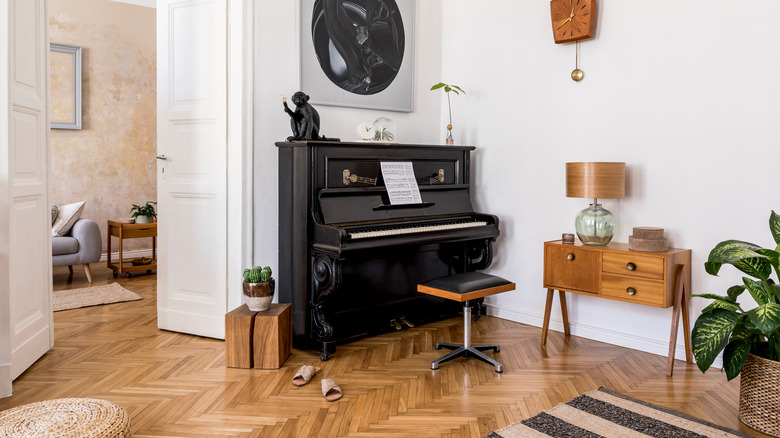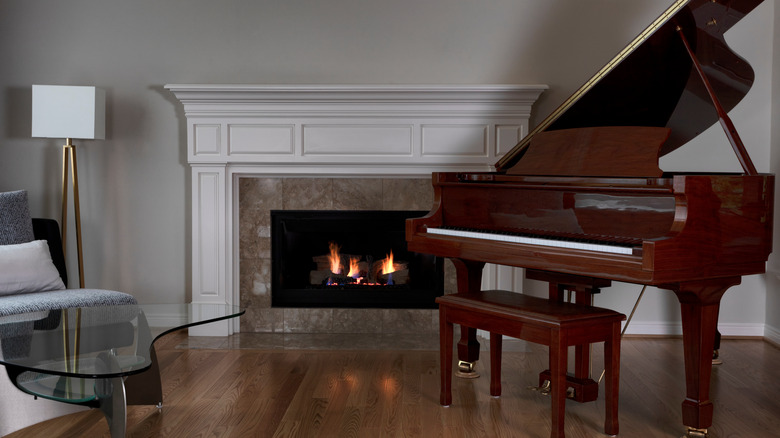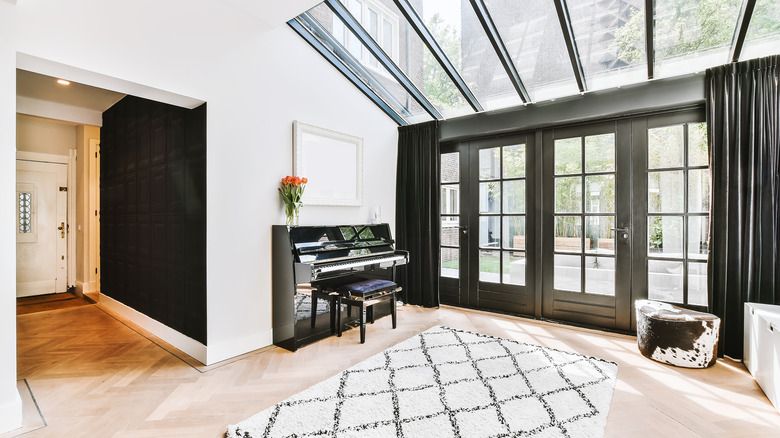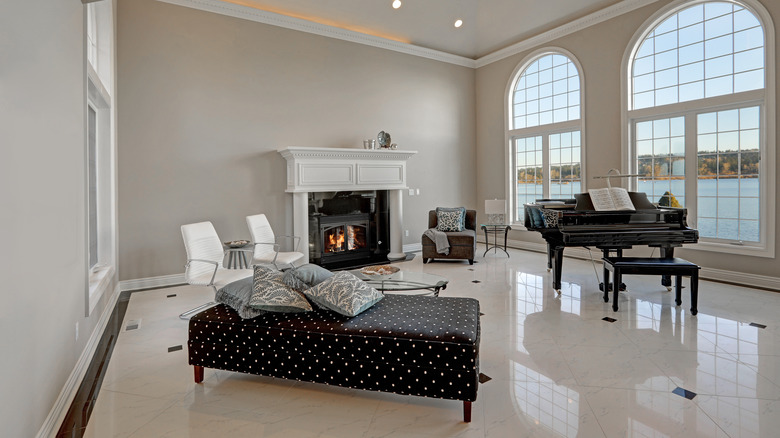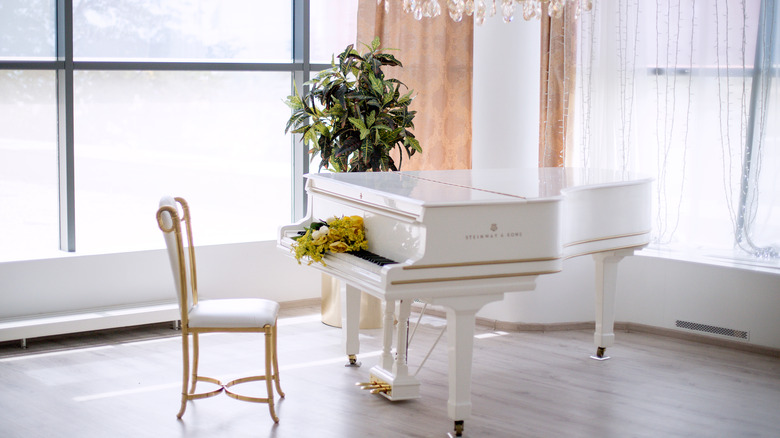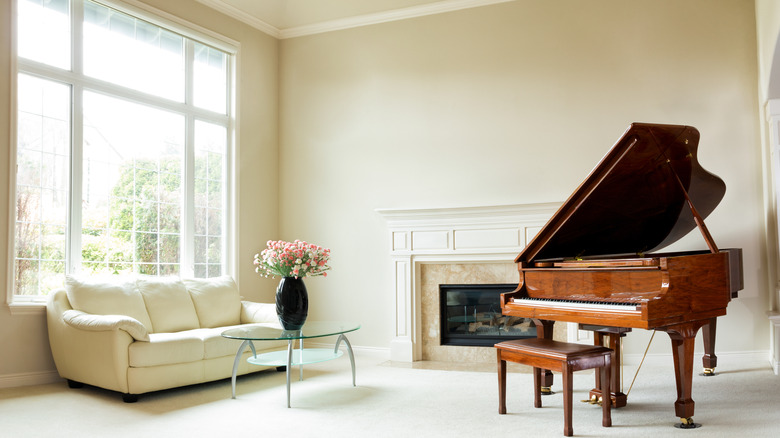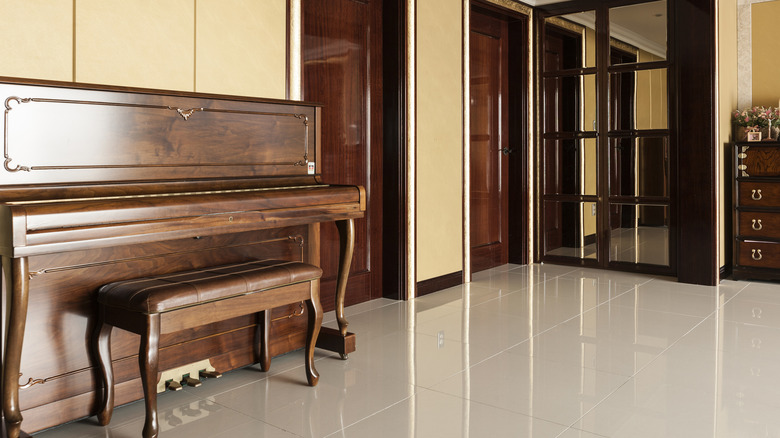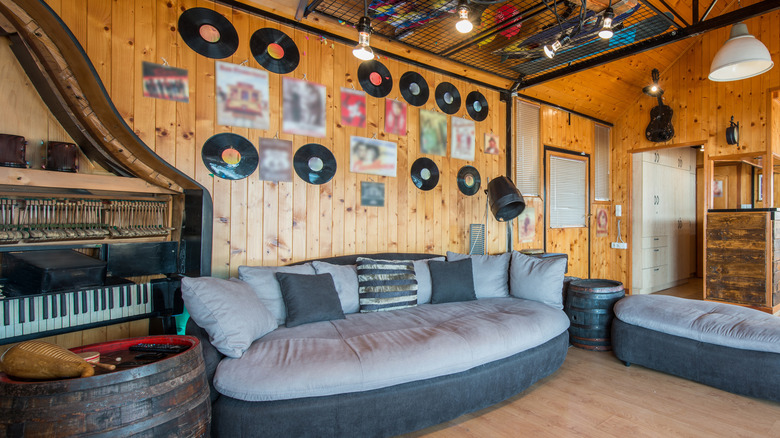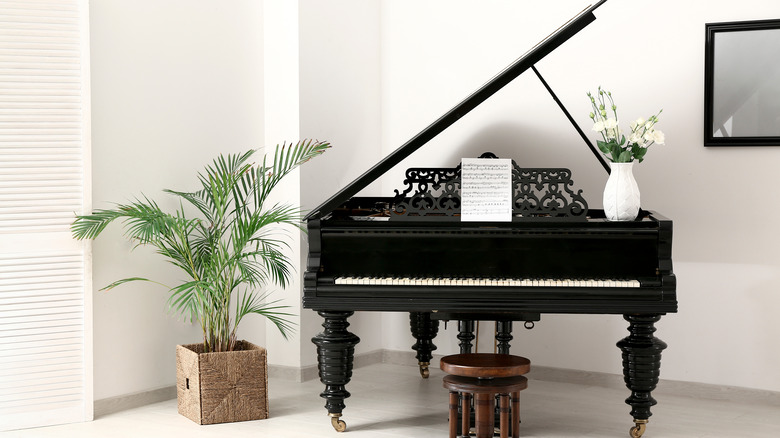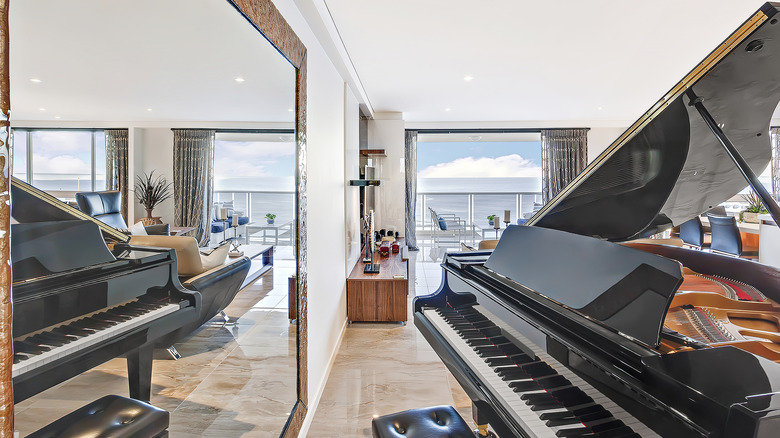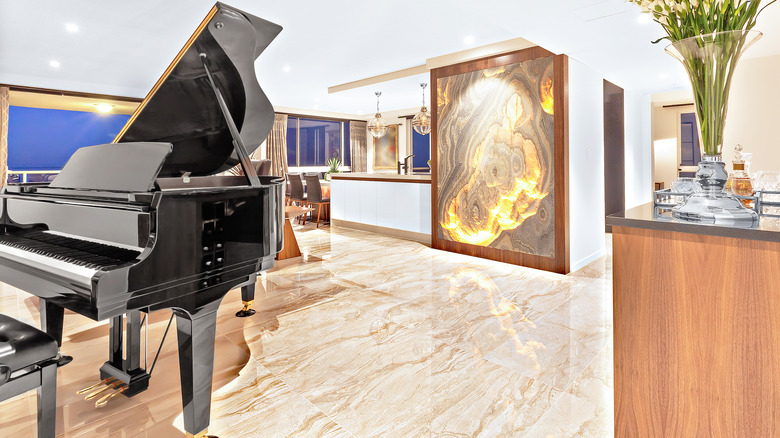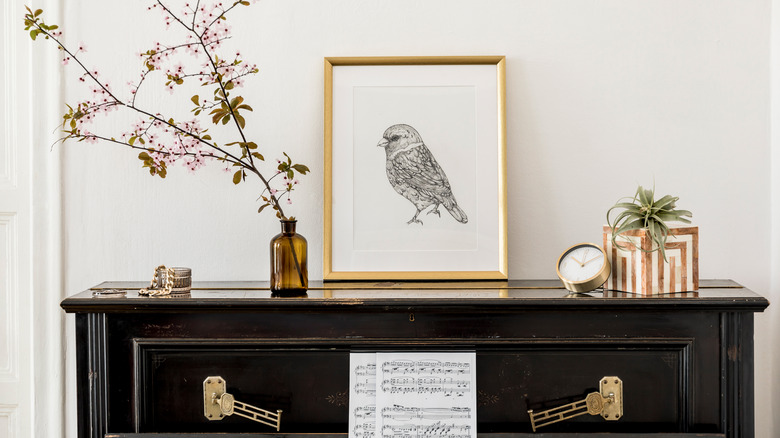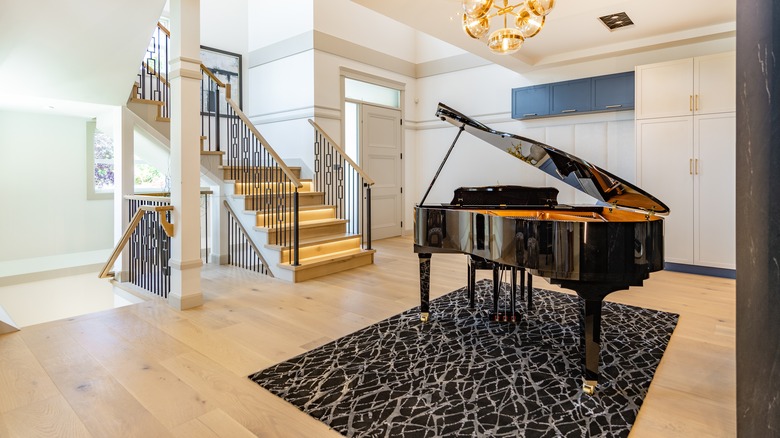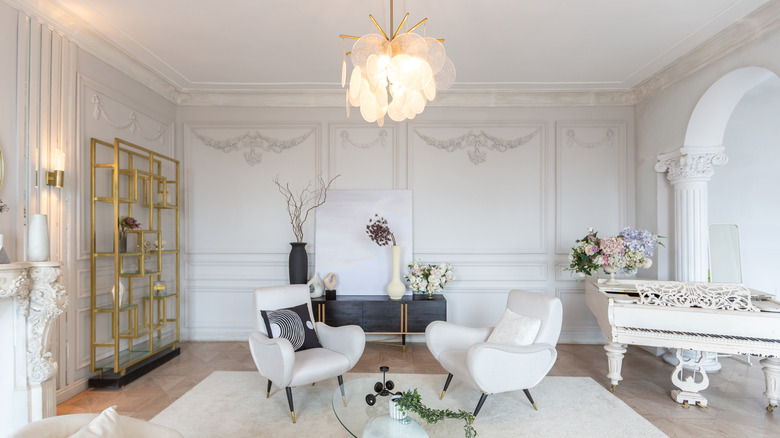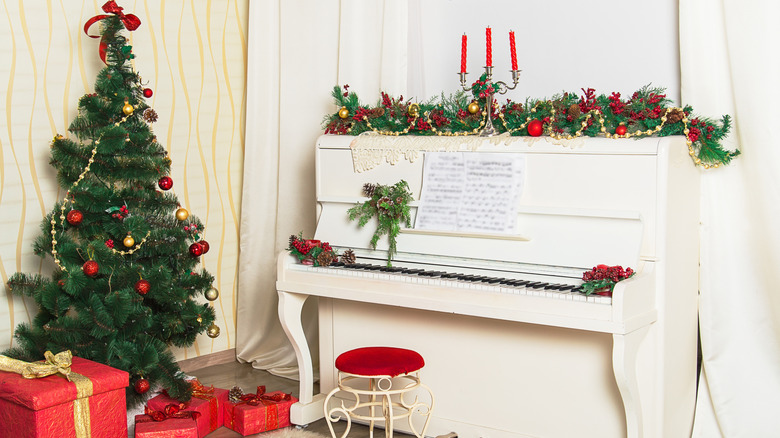How To Style A Piano
Are you a music addict who depends on the soothing melody of a piano to calm down? Or do you play this elegant musical instrument and want to give it a dominant position in the living room? In either case, finding a proper spot to fit this majestic item is crucial if you want to enjoy the classy tunes.
Undoubtedly, pianos look sophisticated and glorious, thus elevating the feel of any home. And besides serving their primary function -– to produce music – Pianu explains that the benefits for your brain are multifold. For instance, piano players are better at multitasking and goal-setting. They also deal with depression easier and are open-minded.
But beyond practical reasons, this luxurious musical instrument can be an ideal décor piece for the interior. Even if nobody plays the piano at home, the display can transform any space into a chic and elegant hideaway. Yet, as bulky and large as a piano can be, you need to pay attention to the surrounding elements. One wrong move and you can turn this visual masterpiece into an intruder.
So, how do you incorporate a piano to fit the rest of the interior? Is it possible to achieve a seamless look that pleases the eye and soothes the soul? Here are 14 ideas to adorn your piano and make it a statement with style and harmony.
Choose a focal point
Since the piano is a significant investment, it's worth giving it a prominent position in the house. Yet, with space constraints and layouts, finding the ideal piano spot can prove challenging. Above all, you must follow several simple rules to make the right decision and eliminate the places that won't fit this impressive piece.
The first step is critical because it will set the scene for what comes next. Once you pick the exact spot for the massive instrument, it will be easier to introduce stylistic elements such as furniture and accessories. Sun and light exposure, traffic, and accessibility should guide you when choosing a focal point.
Modern Piano suggests placing your grand piano against a wall. Conversely, upright versions can go on inner walls, in a specific corner, or in the middle of a room. Try experimenting with the exact location until you get the best acoustics and sound flow. Also, consider keeping other items, particularly bulky ones, away from the instrument to protect it from accidental damage.
Stick with the same theme
A vital thing to remember when styling your piano is to be consistent with the overall theme. This way, you infuse character into the room and make it suit your individual needs. Otherwise, the place will look cluttered and mismatched and tire the eye, making you unable to focus.
Depending on your interests, the theme can be musical, travel-oriented, natural, or family-related. At this point, aligning décor, accessories, and wall art to achieve cohesion is vital. Whether you pick your favorite travel destination, artist, or pattern to adorn the room, this is a great approach to let everyone know what you hold dear.
According to Kreate Cube, industrial, Scandinavian, rustic, Asian, and contemporary are among the best styles for 2022. All designs will perfectly fit a grand piano, provided you pay attention when combining material, texture, color, and shape. Ensure you add music décor to the practice space to keep you focused and motivated as your talent progresses.
Pick complementary hues
Choosing colors that go well together will give the piano room a cohesive look. Ensure the color scheme is consistent across walls, furniture, décor, and rugs. Your ultimate objective is to achieve a warm touch that is pleasing and elevating.
Opt for a harmonious two-color combination for an interior that resonates with calm and tranquility. If you prefer a bolder look, go with contrasting shades, or incorporate a third and fourth compatible tone. Possible two-color combinations include navy and gold, yellow and gray, teal and gray, purple and gold, and peach and black. For the ultimate sophisticated feel, combine black and white with a pop of gold.
When all aspects of the room go well together, it's aesthetically pleasing, reckons Kukun. Consider taking a neutral hue like white, beige, or gray for the foundation, and then another, bolder one to stir up the mood. If you want to introduce a third color, opt for a complementary hue. Narrowing down the color palette to three colors will create a cohesive space. As a result, your piano can blend in, instead of awkwardly standing out.
Another strategy you can try is to mind the room size. Larger areas with a lot of dark furniture call for lighter pianos, whereas brightly-colored furniture goes well with a black piano. This contrast creates depth and elegance, thus avoiding mundane and soulless settings.
Settle for a minimalistic layout
An overly-decorated piano top won't achieve the aesthetical appeal you might be eager to get. Multiple figurines, textures, and photos will throw a shade on the piano's grandeur and clutter the space. Don't fall for this trap. Instead, limit the items you'll display on or around the instrument at the onset. Eventually, you might extend your collection if you have a large-sized piano.
Taking the minimalistic route doesn't mean you should abandon ornaments and bright colors altogether. Instead, use décor elements only as accents to keep your home decluttered and clean, suggests All About Interiors. The same goes for art in the room: Choose one piece instead of several smaller ones that might cramp the space and distract your attention.
Minimalist designs feature furniture and objects with flat surfaces, defined lines, and seamless curves. Even the stunning piano itself can be the focal point without the need to introduce extra details. In this case, make the interior more dramatic by hanging an impressive chandelier over the instrument. Whether you pick a hardwired or corded version, it will infuse a warm and elegant feel, claims Chairish.
Keep it light and airy
The brighter the space is, the more positive vibes it emits. Nobody can enjoy a mesmerizing piano tune in a suffocating room with no sun rays penetrating during the daytime. Keep the space open and ensure you position the instrument next to a windowsill to enjoy the view.
Provided the room gets a lot of sunlight, consider placing the piano in a well-lit nook that naturally draws attention. Conversely, avoid dark corners because your mood could deteriorate. According to Total Wellness Magazine, daylight is a motivation booster, and is critical for stress control and positive thoughts. Moreover, the longer the exposure, the better the brain functions, and your motor learning and memory will enhance.
However, Modern Piano advises against placing the instrument in direct sunlight. If you do so, the finish might quickly fade away, the soundboard can dry, and glue joints weaken. Fluctuating temperatures may further worsen the condition of the piano. To avoid this, use curtains and shades, and stay away from air vents.
Go for a soothing atmosphere
When decorating the piano and around it, it is essential to create a welcoming ambiance. To do so, you should carefully select shapes, materials, and textures. Natural elements like wood, stone, wool, and water-based finishes will bring the intrinsic beauty of raw materials to your home.
So, how do you improve the general mood of the space? Besides practicality, one shouldn't underestimate the feeling of enjoyment when playing and listening to the magical piano sound. Striking a balance between spacious and cozy is vital. An inviting space must appeal to all senses, claims Ving. Introduce a calming scent like lavender or jasmine to encourage you to play often and feel better.
As a next step, introduce soft and natural materials to elevate the overall atmosphere. Bio Friendly Planet explains that wood has been a staple in interior design for centuries. Besides being eco-friendly and versatile, wood invokes a feeling of mindfulness. Natural stones like travertine, granite, limestone, marble, and slate can achieve the same effect.
Finally, turn to traditional soothing spa features that soothe the mind and body. Think about plug-in diffusers or a humidifier to improve air circulation and quality. A water fountain can also do wonders for your inspiration. If adorned with little stones and soothing lights, this element will provide the perfect background for the long practicing hours.
Keep the musical note
If you prefer to practice and show your piano skills daily, you need an area that screams with music and constantly reminds you of your passion and motivation to keep playing. So, why not invest in an actual music room?
Start building your sanctuary by showcasing iconic album covers on the walls. You might also hang records and concert pictures of the musicians you admire. Go for black-and-white furnishings from the 1950s or a Bohemian, colorful look, advises Engel & Völkers' blog. Similarly, instruments like guitars or exotic African drums displayed on stands or wall hooks can make wonderful focal pieces.
Another thing you can't neglect is the soundproofing of the space. Though some methods like introducing an air space between walls are more effective, they are a substantial investment. Yet, Soundproof Cow claims this is the best way to absorb sound and boost acoustics. Prism-patterned foam is a more cost-effective alternative if you're not renovating from scratch.
Let nature in
No place will feel homey and inviting if you disregard the power of plants. Whether you prefer hanging plants or a giant fig, lemon, or dragon tree, the impact on your senses will be incredible. Not only does greenery create a laid-back atmosphere, but it also stimulates your urge to compose and play.
The easiest and fastest way to infuse the piano room with nature is to incorporate more herbs and flowers. Besides healing and therapeutic properties, plants create a serene environment that stimulates creativity, asserts Bio Friendly Planet. If you find it challenging to upkeep lush greenery, go for low-maintenance species like succulents, cacti, or aloe. Also, avoid overly moist plants that require plenty of water because the humidity can interfere with the piano's tuning.
Another hack to turn the piano room into a luxurious setting is to scatter a few bunches of wildflowers around the room. Pair earth tones with pink and lavender like Brown Davis did and repurpose magazine racks to hold practice books and sheet music. Use macramé plant holders to fit your tuners, kazoos, recording devices, and metronomes.
Invest in a unique mirror
If you sense that your living room needs more breathable space, there is an easy way out: You can install a mirror over the piano. Besides making the interior more extravagant and classy, mirrors visually enlarge the room and serve a decorative purpose. So, how do you pick the ideal shape and size?
Mirrors make spaces resonate with brightness. The larger the surface, the more comfortable and airy the room will feel. Be it an antique or futuristic one, consider embellishing your piano room with a one-of-a-kind mirror. On the opposite wall, hang muted-colored art or frames. Thanks to the reflective surface, you can use the sight to stay focused while playing. If you aren't easily distracted, stick with musical décor and colored images that express your personality.
Moreover, mirrors enhance light sources and help conceal flaws in the interior. Harmony Sense advises against placing reflective surfaces in direct sunlight to preserve them longer. Also, avoid bulky items and sofas in front of the mirror because you will burden the room. Typically, two or three pieces are ideal for the ultimate impact of vastness.
Arrange a gallery wall or mural
Provided you position the piano against an interior wall, leaving the background all white is not a wise choice. Creating a gallery wall is a perfect way to invigorate the room and make it personalized. The more individual the selection, the better it reflects your tastes, memories, and dreams.
You can turn any collection of photos, paintings, or memorabilia into a gallery wall. But before anything, look for frames that complement the piano color to make the space compact and streamlined. And since grand pianos grab attention, go with subtle and not overly distracting backdrops. Decorilla lists a few gallery wall layouts you might want to try, including symmetrical, top or bottom aligned, and random arrangements.
As for music room décor, fill the frames with sheet music that is instrumental in your life. Even better, music notes are ideal on murals. Rebel Walls offers a broad selection of music-inspired murals that add interest and stimulate conversation.
Display your trinkets
Contrary to simplicity and flowy lines, you may resort to a complete contrast to highlight your piano. More precisely, the background or top of the instrument can serve as the ideal foundation to display various items and accessories you hold dear.
Decorating the piano area with souvenirs, books, or vases creates a stylish look. You may also use the instrument as a secondary mantel to showcase your DIY skills and integrate the piano into the overall design. Reality in Reverie suggests travel addicts can fill holiday jars, stack different cookbooks or travel guides, or hang a scratch map with all the destinations visited.
Another excellent idea is to fit the piano in the music or book library. Besides being more practical and accessible, this nook can be the perfect hideaway for hectic days. A room design shared by Two Ellie shows lighter bookshelves and sizeable windows can make the space feel open and tranquil. Plus, you have all your sheet music books and theory binders nearby.
Invest in a comfy rug
Though you can always position the piano on a tiled or marbled floor, think twice. Do you like to convey a feeling of coolness and detachment, or warmth and comfort? Tiled and hardwood floors promote resonance, whereas carpeted rooms mute the sound. So, if the second scenario appeals to your senses, placing a rug under the piano is a game-changer.
This way, you can protect the floor underneath the rug. Plus, a carefully selected rug looks stunning from an aesthetic standpoint. Be sure to avoid narrow or small-sized pieces that don't fit all furniture in the room.
When choosing the perfect carpet for the piano room, bear the material and coziness factor in mind. Wool, cotton, jute, sisal, and seagrass are the ultimate natural fibers for your rug. For a less pricey variant, go with a PET synthetic fiber. Moreover, pick high-pile rugs for low-traffic and low-pile rugs for high-traffic areas. Remember that the first option is softer and warmer, but requires more frequent vacuuming.
Don't underestimate proper lighting
The border between choosing spectacular and aggressive lighting when designing a room is easy to cross. What lighting fixtures you install, their position, and how you combine them can affect the overall mood and perception. So, how do you effectively mix and match light hues and styles for a cohesive look?
First, pay attention to the lights' hue and intensity. Border States suggests that cool, blue light improves productivity and alertness. It's ideal for brainstorming rooms where you need your creativity to come to the surface. Dim, yellowish hues will create a relaxing atmosphere. Another great tip to visually extend the room is to place lights on the perimeter.
As for the pairing, install recessed and combine them with two lamps as Brown Davis did in his design. Alternatively, you might introduce pendant lights or a massive chandelier as a focal point. Then, complement the grandeur with less flashy pieces that come in layers. It is also crucial to maintain the same attribute across fixtures. For instance, pick drum-shaped fixtures with the same metal finish.
Cultivate a festive spirit
Are you always in trend with the current season and enjoy decorating for the holidays? In that case, use the piano as a valuable prop for your statements. Adding seasonal ornaments and DIY crafts on top of or adjacent to the instrument will help you keep things fresh as the year progresses.
Always use the piano color and style as a base for decorating. For example, a combination of white, subdued green, and red palette on the piano's brown hue will welcome the Christmas season in your home. Christine Mims lists the steps to create a holiday scene or a winter village on an upright piano. In addition, you can affix a garland and make sheet music snowflakes.
Another way to appreciate the aesthetic value of the keys is to use the flanks to swap seasonal decorations. However, if you don't want to place items on your prized instrument, put flexible displays next to it. Besides being able to play with props as the seasons go by, you'll leave the piano unscratched.
